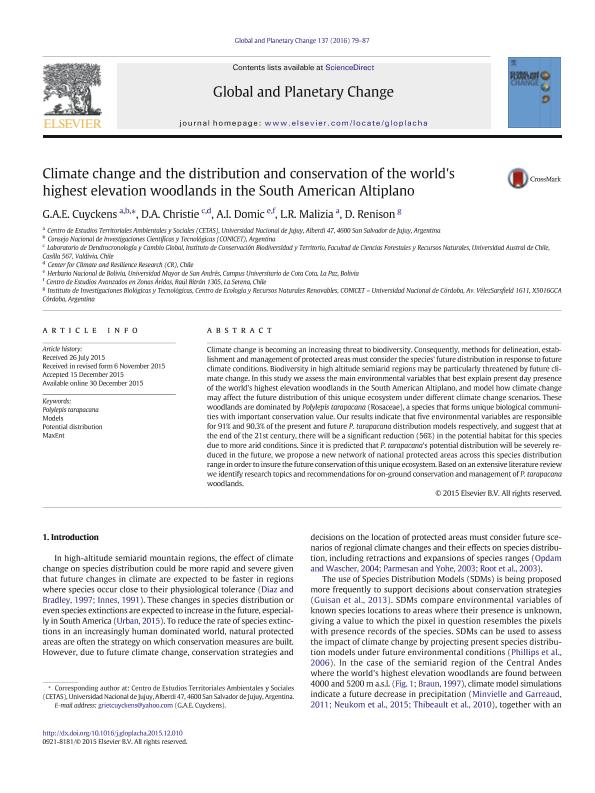Artículo
Climate change and the distribution and conservation of the world's highest elevation woodlands in the South American Altiplano
Fecha de publicación:
02/2016
Editorial:
Elsevier Science
Revista:
Global and Planetary Change
ISSN:
0921-8181
Idioma:
Inglés
Tipo de recurso:
Artículo publicado
Clasificación temática:
Resumen
Climate change is becoming an increasing threat to biodiversity. Consequently, methods for delineation, establishment and management of protected areas must consider the species' future distribution in response to future climate conditions. Biodiversity in high altitude semiarid regions may be particularly threatened by future climate change. In this study we assess the main environmental variables that best explain present day presence of the world's highest elevation woodlands in the South American Altiplano, and model how climate change may affect the future distribution of this unique ecosystem under different climate change scenarios. These woodlands are dominated by Polylepis tarapacana (Rosaceae), a species that forms unique biological communities with important conservation value. Our results indicate that five environmental variables are responsible for 91% and 90.3% of the present and future P. tarapacana distribution models respectively, and suggest that at the end of the 21st century, there will be a significant reduction (56%) in the potential habitat for this species due to more arid conditions. Since it is predicted that P. tarapacana's potential distribution will be severely reduced in the future, we propose a new network of national protected areas across this species distribution range in order to insure the future conservation of this unique ecosystem. Based on an extensive literature review we identify research topics and recommendations for on-ground conservation and management of P. tarapacana woodlands.
Palabras clave:
Maxent
,
Models
,
Polylepis Tarapacana
,
Potential Distribution
Archivos asociados
Licencia
Identificadores
Colecciones
Articulos(IIBYT)
Articulos de INSTITUTO DE INVESTIGACIONES BIOLOGICAS Y TECNOLOGICAS
Articulos de INSTITUTO DE INVESTIGACIONES BIOLOGICAS Y TECNOLOGICAS
Citación
Cuyckens, Griet An Erica; Christie, D. A.; Domic, A. I.; Malizia, Lucio Ricardo; Renison, Daniel; Climate change and the distribution and conservation of the world's highest elevation woodlands in the South American Altiplano; Elsevier Science; Global and Planetary Change; 137; 2-2016; 79-87
Compartir
Altmétricas




